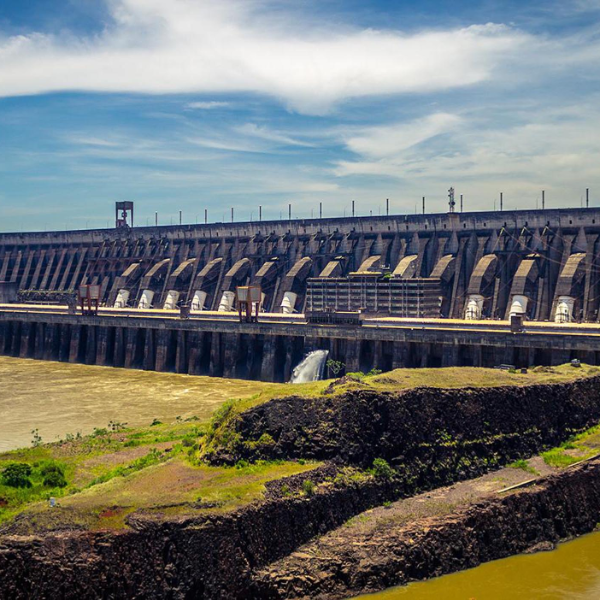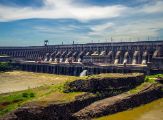Feasibility of shipping bypass near Itaipu Dam

Feasibility of shipping bypass near Itaipu Dam
A shipping bypass next to the Itaipu Dam, one of the world’s largest dams, could create the potential to significantly develop and improve the sustainability of the economies of five Latin American countries. For this reason, the dam’s management company Itaipu Binacional commissioned Witteveen+Bos to conduct a technical, economic, ecological and social feasibility study for a bypass featuring locks. Such a bypass would allow shipping traffic to cross the upper reaches of the Paraná River at the border between Brazil and Paraguay.
The world's largest hydroelectric power plant
The 7.7 km-long Itaipu Dam is the largest hydroelectric power plant in the world and possesses a unique capacity for producing sustainable energy. It is also considered one of the modern world’s seven engineering wonders by the American Society of Civil Engineers. The dam’s hydroelectric turbines produce 100 TWh of sustainable energy each year, which is enough to meet 90 % of Paraguay’s national energy needs and 19 % of Brazil’s. Due to an increase in transport over the past decade, Itaipu Binacional elected to commission a feasibility study for a shipping bypass next to the Itaipu Dam. Witteveen+Bos is investigating the technical, economic, ecological and social feasibility of this bypass over the Paraná River.
The preliminary design
In the preliminary design produced by Witteveen+Bos, the huge difference in height of 125 metres is overcome by a 6 km-long canal featuring four locks (the second and third locks form a staircase) to enable a ship’s passage from upstream to downstream of the dam. Nautical fast-time analysis has shown that a 160-by-16 m barge convoy can safely approach the locks despite the high-velocity flows downstream. The project’s construction costs are estimated at USD 1.3 to 1.8 billion.
One of the design’s biggest challenges was that all the infrastructure has to be ‘lifted’ above the basalt to avoid as much excavation as possible. In all previous studies, this comprised the biggest cost item. Another significant challenge involved designing the bypass’s water system in such a way as to limit the amount of water that is ‘lost’ (i.e. not utilised) in the process. All such water would represent an immediate loss of revenue for Itaipu Binacional as no energy could be generated by it.
Economic growth and logistical sustainability
As the economy grows, so too will the need for transport. One of the biggest advantages of waterways is that they offer a more sustainable transport mode. A convoy of twenty inland shipping vessels, for example, can transport 30 thousand tonnes with a fuel consumption of 5 litres/tonne/km. 1,200 trucks would be needed to transport the same freight, with a fuel consumption of 218 litres/tonne/km. The Paraguay-Paraná waterway is also a major development opportunity for five different countries: Paraguay, Brazil, Uruguay, Argentina and Bolivia.
An economic analysis investigated the potential benefits and weighed them up against the investment and maintenance costs of the bypass. The future benefits generated are sufficient to justify the investment, and the accompanying environmental and social impact can be mitigated.
Complex challenge
Paul Ravenstijn, managing director of Witteveen+Bos’s front office in Panama: ‘We want to contribute to sustainable water management and energy generation on the one hand, and to sustainable transport and economic development on the other. Also, rivers are fragile ecosystems that can nevertheless provide an important solution to climate and environmental problems surrounding energy production, food security and mobility. This makes the study complex and specialist knowledge essential, which is why we’re collaborating with two renowned parties. For determining the nautical feasibility using fast-time simulations we’re collaborating with MARIN, the world’s largest independent research institute in the maritime industry. Determining the transport prognosis is being done together with STC-Nestra/Gistran.’
The study also focuses on factors related to social impact, such as stakeholder interests, the local community and the impact on society. After all, without social acceptance technical designs are useless. The feasibility study is being carried out using Witteveen+Bos’s innovative ‘integrated design’ method, in which our seven sustainable design principles are applied as much as possible. Both Witteveen+Bos and the client endorse the UN’s seventeen Sustainable Development Goals. This means that both parties are committed to ending poverty and hunger, protecting human rights and promoting gender equality.

Our projects
Every year we work on almost 5,000 projects on water, infrastructure, environment and construction.

More information?




